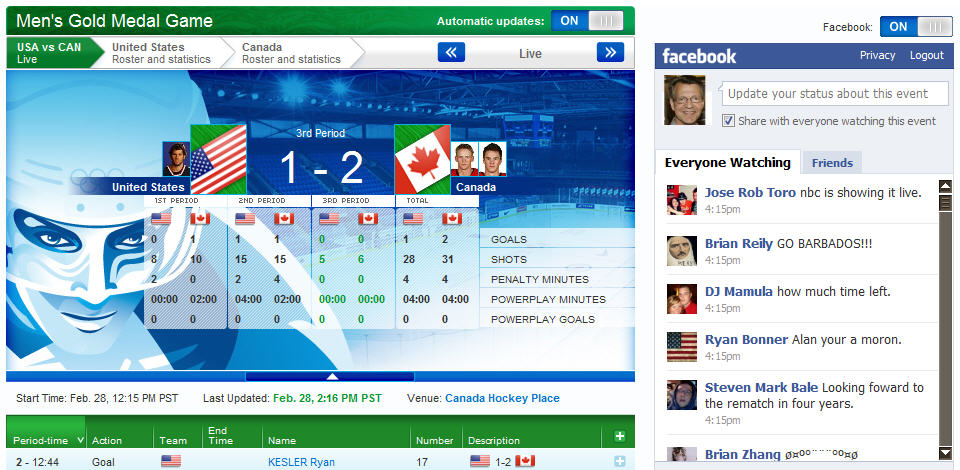You’d think it would be impossible to get those who haven’t signed up for Twitter to get hooked on the immediacy and community of “tweeting.” You’d be wrong.
Just now I wanted to watch the statistics while I had the USA – Canada Olympic Gold Hockey Game on the television. I logged into the official Winter Olympics site. I found paydirt — and a surprising real-time Facebook status feed. You can click the image for one that’s easier to read:
What struck me about the Facebook feed is I didn’t have to log in. Since I already had Facebook loaded in another browser window, it immediately gave me the opportunity to add my own two cents to the cheering / jeering session. I didn’t, but I did find the flow of other people’s comments to be a fun addition to my solo enjoyment of the game.
I’ve written before about how Facebook is a perfect set of social media training wheels for the newbie. This is more evidence.

Comments
2 responses to “How to get non-Twitter users to tweet”
While I agree that Facebook is a fantastic start for anyone trying out social media, I was intrigued by the title of your post here.
How to get folks to move on from Facebook to even try Twitter….C’mon, Jeff, you’re the one who got ME hooked on Twitter. What are your thoughts?
Good question, Ann. I should have been more clear.
Social media are changing our behaviors. Most of us those behaviors are happening in small increments.
Someone who is on Facebook may or may not be posting their statuses consistently. I can imagine someone who uses Facebook exclusively to follow family members — through new photos, their status messages, etc. That makes them, to use Forrester’s term, “Spectators.” They’ve joined Facebook but are mostly only lurking there.
Suddenly, when they visit the Olympic site to follow the hockey game, a window shows their Facebook profile picture, along with a scrolling feed of other people’s comments. The temptation to join the fray had to be great for a lot of people who were new to this type of conversation. Many I’m sure succumbed. The number of comments streaming by — especially during the last minutes of the official play and overtime — was quite impressive.
In the time frame of a hockey game, those who piped up and commented there graduated from Spectator to “Joiner.” For some, I suspect the game has caused them to go ahead and sign up for Twitter — or become active in an existing Twitter account that had been idle.
Together, that exciting game, the clever web interface, and the Facebook feed, combined to became a powerful gateway drug into Twitter use.